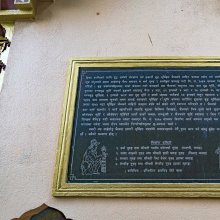Pema: 5 definitions
Introduction:
Pema means something in Buddhism, Pali, the history of ancient India, Jainism, Prakrit, biology. If you want to know the exact meaning, history, etymology or English translation of this term then check out the descriptions on this page. Add your comment or reference to a book if you want to contribute to this summary article.
Images (photo gallery)
India history and geography
Source: Mandala Texts: Parzo: Wood CarvingPema (པདྨ་) refers to a traditional Bhutanese window structure design made with wood-carving (patra).—Wood carvings are an important part of a traditional Bhutanese architectural designs. Pillars in the temples and dzongs and railings for a balcony often have intricate carvings either made in them or attached to them. Texts in Lantsha script are often carved on temple structures and many motifs and symbols are carved on the pillars and beams. The main pillars in the temples and dzongs are heavily laden with carvings showing many auspicious symbols and designs. Even for a fairly simple building, the traditional window structures always contain pema (པདྨ་) and chotse (ཆོས་བརྩེགས་) designs, and the zhu (གཞུ་) and tshegye (ཚེ་རྒྱས་) structures, which are manually carved by the carpentars.

The history of India traces the identification of countries, villages, towns and other regions of India, as well as mythology, zoology, royal dynasties, rulers, tribes, local festivities and traditions and regional languages. Ancient India enjoyed religious freedom and encourages the path of Dharma, a concept common to Buddhism, Hinduism, and Jainism.
Biology (plants and animals)
Source: Google Books: CRC World Dictionary (Regional names)Pema in Nepal is the name of a plant defined with Potentilla fruticosa in various botanical sources. This page contains potential references in Ayurveda, modern medicine, and other folk traditions or local practices It has the synonym Potentilla rigida Wall. ex Lehm. (among others).
Example references for further research on medicinal uses or toxicity (see latin names for full list):
· Bibliotheca Botanica (1908)
· Prodromus Florae Nepalensis (1825)
· Mélanges Biologiques Tirés du Bulletin Physico-Mathématique de l’Académie Impériale des Sciences de St.-Pétersbourg (1873)
· Revisionem Potentillarum (1856)
If you are looking for specific details regarding Pema, for example extract dosage, health benefits, chemical composition, side effects, pregnancy safety, diet and recipes, have a look at these references.

This sections includes definitions from the five kingdoms of living things: Animals, Plants, Fungi, Protists and Monera. It will include both the official binomial nomenclature (scientific names usually in Latin) as well as regional spellings and variants.
Languages of India and abroad
Pali-English dictionary
Source: BuddhaSasana: Concise Pali-English Dictionarypema : (nt.) love; affecting.
Source: Sutta: The Pali Text Society's Pali-English DictionaryPema, (nt.) (fr. prī, see pīṇeti & piya & cp. BSk. prema Jtm 221; Vedic preman cons. stem) love, affection D. I, 50; III, 284 sq.; M. I, 101 sq.; S. III, 122; IV, 72, 329; V, 89, 379; A. II, 213; III, 326 sq.; Sn. 41; Dh. 321; DA. I, 75.—(a)vigata-pema with(out) love or affection D. III, 238, 252; S. III, 7 sq. , 107 sq. , 170; IV, 387; A. II, 174 sq.; IV, 15, 36, 461 sq. (Page 472)

Pali is the language of the Tipiṭaka, which is the sacred canon of Theravāda Buddhism and contains much of the Buddha’s speech. Closeley related to Sanskrit, both languages are used interchangeably between religions.
Prakrit-English dictionary
Source: DDSA: Paia-sadda-mahannavo; a comprehensive Prakrit Hindi dictionaryPema (पेम) in the Prakrit language is related to the Sanskrit word: Preman.
Prakrit is an ancient language closely associated with both Pali and Sanskrit. Jain literature is often composed in this language or sub-dialects, such as the Agamas and their commentaries which are written in Ardhamagadhi and Maharashtri Prakrit. The earliest extant texts can be dated to as early as the 4th century BCE although core portions might be older.
See also (Relevant definitions)
Starts with: Pema Lingpa, Pema Sutta, Pemachen, Pemaka, Pemalam, Pemalua, Pemani, Pemaniya, Pemarutti, Pemarutu.
Ends with: Ppema.
Full-text: Pemaka, Prema, Pema Sutta, Pema Lingpa, Pemaniya, Wangzhing, Premna, Phag-cham, Pacham, Pundarika, Guru Chowang, Longchenpa, Mewang, Sineha, Zhu, Chotse, Tshegye, Patra, Piya, Kama.
Relevant text
Search found 6 books and stories containing Pema, Pēma; (plurals include: Pemas, Pēmas). You can also click to the full overview containing English textual excerpts. Below are direct links for the most relevant articles:
Bodhisattvacharyavatara (by Andreas Kretschmar)
Interview With Khenpo Pema Sherab < [Introduction Text]
Text Sections 130-131 < [Khenpo Chöga’s Oral Explanations]
Interview with Kyabje Khenpo Trashi Palden < [Introduction Text]
Abhidhamma in Daily Life (by Ashin Janakabhivamsa) (by Ashin Janakabhivamsa)
Factor 5 - Lobha (greed) < [Chapter 2 - On akusala cetasikas (unwholesome mental factors)]
Factor 8 - Mettá (loving-kindness) < [Chapter 3 - On kusala cetasikas (wholesome mental factors)]
The Great Chronicle of Buddhas (by Ven. Mingun Sayadaw)
(9) Ninth Pāramī: The Perfection of Loving-kindness (mettā-pāramī) < [Chapter 6 - On Pāramitā]
Part 1 - Story of Kukkuṭamitta the Hunter < [Chapter 34c - The Buddha’s Nineteenth Vassa also at Cāliya Hill]
Dhammapada (Illustrated) (by Ven. Weagoda Sarada Maha Thero)
Verse 296-301 - The Story of a Wood Cutter’s Son < [Chapter 21 - Pakiṇṇaka Vagga (Miscellaneous)]
A Manual of Abhidhamma (by Nārada Thera)
Compendium of Calm < [Chapter IX - Mental Culture]
52 Kinds of Mental States < [Chapter II - Mental States]
The Buddha and His Teachings (by Narada Thera)
